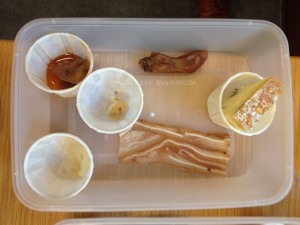The pleasures of texture
This is a video of a magnificent dried sea cucumber after two days of soaking and slow-cooking. As you can see, it has a lazy, springy, sticky texture. When I brought it home, dry and rock-hard like a fossil, it had an unpleasant fishy smell (like Bombay Duck, if anyone can remember that). But after the requisite soaking and simmering, it had virtually no aroma or flavour: it had been reduced to pure, glorious texture – which meant it was ready to be cooked. Isn’t it amazing?
One of the great barriers to outsiders’ appreciation of Chinese food is the Chinese love of textures that others consider revolting, as I’ve written before: the slimy, slithery, bouncy and rubbery; the wet crispness of gristle; the brisk snappiness of goose intestines; the sticky voluptuousness of that reconstituted dried sea cucucmber. This was the subject of a talk I gave as part of a London Gastronomy Seminar last week, following an excellent exposition by French psychologist Dominique Valentin on the cultural influence on food choices.
 We ended the evening with a tutored tasting of some classic ‘texture foods’ (pictured right): naked, undressed jellyfish in all its crisp slitheriness, a terrine of pressed pig’s ear, layered with thin sheets of crunchy cartilage; sticky ox tendons in a spicy sauce; and then, for each guest, a duck’s tongue, which is a perfect example of a Chinese delicacy with a ‘high grapple factor’, which is to say one that requires a detailed, concentrated engagement of tongue and teeth to separate out the bouncy flesh and slender spikes of cartilage. We also had a comparative tasting of fermented tofu and Stilton, to highlight the distinction made by some Chinese friends of mine between what they found the clean, rapidly-dispersing stinkiness of fermented tofu, and the greasy, clingy, mouth-coating stinkiness of cheese.
We ended the evening with a tutored tasting of some classic ‘texture foods’ (pictured right): naked, undressed jellyfish in all its crisp slitheriness, a terrine of pressed pig’s ear, layered with thin sheets of crunchy cartilage; sticky ox tendons in a spicy sauce; and then, for each guest, a duck’s tongue, which is a perfect example of a Chinese delicacy with a ‘high grapple factor’, which is to say one that requires a detailed, concentrated engagement of tongue and teeth to separate out the bouncy flesh and slender spikes of cartilage. We also had a comparative tasting of fermented tofu and Stilton, to highlight the distinction made by some Chinese friends of mine between what they found the clean, rapidly-dispersing stinkiness of fermented tofu, and the greasy, clingy, mouth-coating stinkiness of cheese.
It gave me great pleasure to see a whole roomful of people eating (in most cases) their first duck tongue, in the intentional pursuit of pleasure. (I’ve received quite a number of emails from readers of my book ‘Shark’s Fin and Sichuan Pepper’ who say that they’ve tried eating ‘rubbery things’ with a completely different, open-minded attitude after reading the chapter ‘The Rubber Factor’, which attempts to explain why the Chinese enjoy eating flavourless foods with interesting textures.)

8 Responses to “The pleasures of texture”
THe tricky thing when trying some of these foods in the UK is the uncertainty about whether they’ve been correctly cooked. My first experience of chicken’s feet and fish maws in London’s Chinatown was distinctly unimpressive, whereas when I tried them again in Hong Kong I thought they were amazing, and I can only put that down to the chef having done a better job.
Great blog, by the way, and the sea cucumber vid is great (though I’d disagree with you about Bombay duck tasting unpleasantly fishy – I love the stuff!)
Fucshia: Once again, you have demonstrated your intimate and insightful knowledge of Chinese food culture. I always have the opinion that tofu and its varied derivatives are examples of “texture” food, Thanks for the excellent article!
Ah yes, duck tongues. I remember my first experience in Changsha, struggling to get to the flesh, much to the amusement of the Chinese professor sitting opposite me.
It’s fascinating how textures can influence the taste of food…
Thanks for another well written and thought-provoking piece.
I’ve added your ‘blog to your profile on GoodReads; I hope you don’t mind.
More about texture on the BBC website, here:
http://www.bbc.co.uk/food/0/22972268
Thanks for all these lovely comments!
John – actually I meant Bombay Duck has a fearsome SMELL, and have now amended the post (thanks for flagging this up). Of course it tastes delicious – and that unsoaked sea cucumber was totally inedible so I didn’t eat any of it, just had a good sniff…
Lee – no of course that’s fine!
Yeah, texture… I gues in modern western countries, that kind of food has gone the way all things old fashioned. Living in Japan, I’ve had to get used to so many things. Most of it has become ok for me, but a few are still not possible. Chicken cartilage, fish eggs, fish semen (yeah, I didn’t know what it was at the time), whale (again, had no clue as to what it was), sea snail and a few others. I can now eat raw horse, intestines, chewy meat, fatty meat, crunchy seaweed and many others. Honestly though, I’m glad that I don’t have to survive on that food!
Hi Fuchsia,
My wife and I absolutely love Every Grain of Rice, we just can’t get enough of it!
Are there any more talks/tastings like this planned for 2013? We’d love to pop along to one and try something new!
all the best.